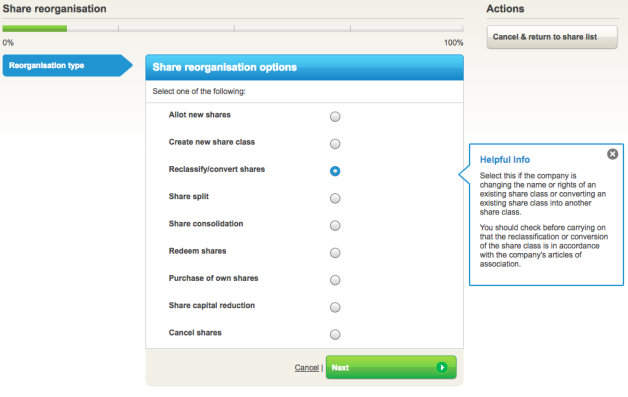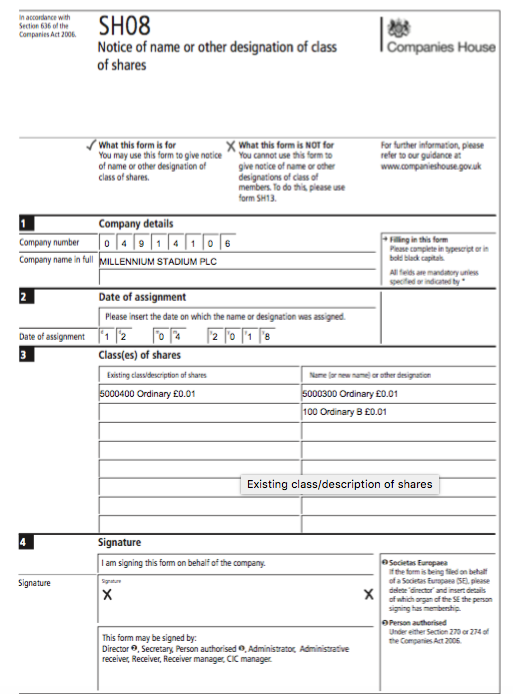We have written previously about why a company might want to add new share classes, e.g. changing some or all of a company’s ordinary shares to A and B shares (alphabet shares). That post can be found here: Why might a company want multiple share classes?
We have also written a separate guide on How to create a new share class.
In this blog we will lay out the practical steps to follow when changing or reclassifying existing shares from one class to another.
Following the steps below should enable most companies to change their share structure by reclassifying shares.
Need help keeping tabs on your shareholders?
Inform Direct will help you to manage your shareholders, create share certificates and issue dividend vouchers all in one place.
Not only that, but you will get the option to produce a pre-populated board minute
1. Make sure the articles of association allow share redesignations.
For a company to carry out a share redesignation, its articles of association must:
- Allow different share classes
- Be free of any clauses that restrict or prohibit the conversion of one share class to another.
It might be necessary to make changes to the articles of association to allow the company to reclassify shares. The Model Articles that many companies use at incorporation only cover one class of ordinary shares. This makes the Model Articles insufficient for companies that want to create multiple classes of share and/or convert shares from one class to another.
If the company’s articles of association don’t allow multiple share classes, a special resolution will be needed to change the articles to enable the company to have multiple share classes. We cover the details of this process in our article How to change a company’s articles of association.
If you have the new articles to hand, the quickest way to get them approved is to circulate the articles with a copy of a written resolution to all shareholders with voting rights and ask them to sign it. See the downloads box in this article for templates that do this at the same time as the share reclassification.
Inform Direct has taken the inconvenience out of drawing up amended articles by creating the Inform Direct Enhanced Articles (IDEA). These are downloadable in versions for one, two and three share classes and fix the issue described above as well as several other insufficiencies of the Model Articles.
2. Propose an ordinary resolution to redesignate shares.
With appropriate articles of association in place, it is then necessary to get shareholder approval for the share reclassification. This can be obtained via an ordinary resolution. A simple majority of over 50% is required (unless the articles say otherwise!) and the vote can be taken at a General Meeting such as the AGM. More commonly and without the need to call a shareholder meeting, the vote can be taken via written resolution. This resolution once passed should be filed at Companies House within 15 days.
The resolution should cover:
- The name(s) of the shareholder(s) whose shares are going to be redesignated
- The original share class
- The name or designation of the new share class.
Keep board minutes of all relevant meetings and copies of the resolutions. These are used to support the notification of the share redesignation to Companies House.
3. Submit an SH08 form.
Where a company assigns a new name or other designation to a class of shares, it must deliver to the registrar a notice giving the particulars of the change. In practice, this means completing and submitting form SH08 to Companies House. The following details are needed:
- Company number
- Date
- Existing class or description of shares, g. ‘ordinary’
- Name or designation of the share class to be renamed to, g. ‘ordinary A’, ‘B’, etc.
If prescribed particulars (the rights and restrictions attached to a share class) are changing then it is also necessary to submit an SH10 form. More often than not both forms are necessary for share redesignations.
- Form SH08 is ‘notice of name or other designation of shares’.
- Form SH10 is ‘notice of particulars of variation of rights attached to shares’.
Resolutions to redesignate shares and change articles
Free, downloadable resolutions to redesignate shares and change articles.
Downloads posted in: Share allotment resources
Where shares are reclassified, commonly both forms SH08 and SH10 need to be submitted to Companies House as both the name and the prescribed particulars are likely to be changing. But:
- If the prescribed particulars are not changing but the name of the share class is changing, then only form SH08 is required.
- If the prescribed particulars are changing but the name of the share class stays the same, only form SH10 is required.
Which forms are necessary will depend on the purpose of the alphabet shares and whether they have different prescribed particulars. In practice they may sometimes have the same prescribed particulars, with the multiple share classes existing only so that the board can declare dividends on different dates and at different rates according to share class.
When submitting either or both of these forms, include minutes of the directors’ meeting where it was decided to reclassify shares and copies of the relevant resolutions.
4. Update the register of members.
Amend the company’s register of members with the class of share, value per share and total number of shares held by each shareholder. Store the register of members at the registered address or SAIL (Single Alternative Inspection Location) of the company as hard copy as well as electronically.
Check the new share structure to see whether a shareholder has become a PSC (Person with Significant Control) due to a change in their shareholding. This applies particularly when there have been other share operations in addition to the redesignation, such as new share issues and transfers. When the dust has settled it may turn out that the company has a new PSC or that someone has ceased to be a PSC. If there has been a change here, the PSC register will need to be updated.
5. Issue new share certificates.
Within two months of the reclassification, issue new share certificates to those whose shares have changed. Where a shareholder has shares in more than one class, they should receive a separate share certificate for the shares in each class. Ask for the return of old share certificates and cancel them by writing ‘cancelled’ across them.
6. Reflect the changes in the next confirmation statement.
As a result of the reclassification a new statement of capital and list of shareholders are needed in the next confirmation statement to give Companies House the up-to-date position.
7. Consider whether HMRC need to be informed.
The point being that HMRC only need to be advised in certain circumstances such as in a family company, if shares are issued to a lower-tax paying relative or spouse at less than their market value and “by reason of their employment”. In which case form 42 will need to be completed.
This has been a guide to the practicalities of reclassifying shares. For a guide to how multiple share classes can be used, please see our article How can a company use multiple share classes?
Manage shareholder records and company registers easily in Inform Direct: dedicated company secretarial software that saves time and keeps everything organised.


